How to Cite | Publication History | PlumX Article Matrix
Mohammad Moneruzzaman Khandaker, Fatin Rohani, Tahir Dalorima and Nashriyah Mat
School of Agriculture Science and Biotechnology, Faculty of Bioresources and Food Industry, University of Sultan Zainal Abidin, Tembila Campus, 22200 Besut, Terengganu, Malaysia.
Corresponding Author E-mail: moneruzzaman@unisza.edu.my
DOI : http://dx.doi.org/10.13005/bbra/2434
ABSTRACT: This study was designed to observe the effects of different organic fertilizers on growth, yield and quality of Capsicum annuum L. var Kulai (Red Chili Kulai). The field experiment was conducted at a green house of Faculty of Bioresources and Food Industry, Universiti Sultan Zainal Abidin (UniSZA), Tembila Campus, Kuala Terengganu. Performance of chilli plant was assessed by application of different organic fertilizer (vermicompost (VC),chicken dung (CiD), peat moss (PM), fermented fish waste (FFW), and cow dung (CoD)). The treatments were fitted in a Completely Randomized Design (CRD) design layouts. Data collected for growth, yield and quality performances included plant height, number of leaf per plant, leaf area, number of branch per plant, stomata conductance, chlorophyll content, number of flower bud per plant, number of fruit per plant, weight of fruit, length of fruit, diameter of fruit and number of seed per fruit. Based on the results obtained from this experiment, application of vermicompost and chicken dung shows highest growth, quality and yield performance. Control treatment (without organic fertilizer) showed the lowest growth, yield and quality response.
KEYWORDS: Capsicum annuum; growth; organic fertilizer; yield; quality
Download this article as:| Copy the following to cite this article: Khandaker M. M, Rohani F, Dalorima T, Mat N. Effects of Different Organic Fertilizers on Growth, Yield and Quality of Capsicum Annuum L. Var. Kulai (Red Chilli Kulai). Biosci Biotech Res Asia 2017;14(1). |
| Copy the following to cite this URL: Khandaker M. M, Rohani F, Dalorima T, Mat N. Effects of Different Organic Fertilizers on Growth, Yield and Quality of Capsicum Annuum L. Var. Kulai (Red Chilli Kulai). Biosci Biotech Res Asia 2017;14(1). Available from: https://www.biotech-asia.org/?p=22864 |
Introduction
Capsicum annuum L. var. Kulai belong to the family Solanaceae. The name comes from Nahuat via the Spanish word chili. The origin of chilli is South America, but mostly cultivated in Asia country such as Cambodia, Philippines, India, Laos, Malaysia, Myanmar, Thailand and many others. Chilli was introduced to tropical countries from Americans by Spanish and Portuguese. Chilli is not a native crop in Malaysia, but they are most second famous fruit vegetables. Chilli has special biochemical content, especially in red chilli, which very rich in vitamin C and pro-vitamin A. Their high vitamin C content give effect in substantially increases the uptake of non-heme iron from other ingredients in a meal, such as beans and grains.1 However, unripe chilli content lower amount of vitamin C and pro-vitamin A.2 In addition, chillis are important as a good source of vitamin B, vitamin B6 and also high in potassium, magnesium and iron. Vimala et al 3 reported that orgnic fertilizer poulty manure regulate the growth chilli plant and increased the fruit length.
Organic fertilizers are organic materials that are more environmentally friendly compare to chemical fertilizers. In order to qualify as an organic fertilizer, the materials must naturally occur in nature. Usually, organic fertilizer is typically made of single ingredients. Thus, the types of organic fertilizers are derived from plant, animal, or mineral sources. The organic fertilizers may supply nutrients to soil but, differences type of source of fertilizer can give some different effect on plant. For example fertilizer that used plant-based fertilizer, helping in improving drainage and moisture retention to poor soils. Furthermore, when applying animal based fertilizer it will give great effect for leafy plants and strong growth in the early week of gardening. Effect that can give when applying mineral based fertilizer is raise or lowering the pH level when needed for healthy plant growth.
Organic farming provides several benefits to the growers. It reduces production cost and it is an environmentally friendly method of cultivation. Addition of organic fertilizers improves soil structure and enhances activities of useful soil organisms.4 In recent times, consumers are demanding higher quality and safer food and highly interested in organic products.5 Agricultural commodities resulted from organic cultivation are good for human health.
Chilli plants response well to inorganic fertilizers in terms of early vegetative growth but it decreased at later stage. Farmers nowadays keep on applying inorganic fertilizer for their crop as it can provide rapid nutrition but it will increase cost of production. Inorganic fertilizer is made up from synthetic materials, when excess of application, the soil will become toxic. Thus, this study intends to provide an alternative method by using several of organic treatment for enhancing growth, yield and quality of chilli.
From this study, the best of organic treatment can be determined for optimum growth, yield and quality of chilli. Farmers may use those treatments as an alternative ways in order to avoid excessive application of chemical fertilizer to the soil. Besides, farmers will have a proper management toward nutrients required for growth and completion of life cycle of the chilli plant. Organic fertilizers may help farmer to increase soil structure, provide food source for soil organisms, provides cation exchange capacity, increases water-holding capacity, decrease toxicity at low pH and act as reservoir of plant nutrients.
Materials and Methods
Plants and Materials
An experiment was conducted in the greenhouse of the KUSZA farm, UniSZA Malaysia. The chilli seeds, (Capsicum annuum L. Var Kulai ,red chili kulai), were bought from Koperasi Peladang Negeri Terengganu and sown on a seedling tray under shed then later transplanted after 4 weeks unto a polybag in the greenhouse. The mean relative humidity and temperature of the study site was about 60 ± 10 % and 22 ± 2°C, respectively.
Treatment Preparation
Experimental soil was prepared using top soil (sand+compost) and six different organics treatment were mixed at the of ratio 1:1. The organics treatments that were used are vermicompost (VC), chicken dung (CiD), peat moss (PM), fermented fish waste (FFW), and cow dung (CoD). For preparation of fermented fish waste (FFW), the procedure was according to the method describe by Zynudheen et al.,6 Then, the mixture of soil was filled into polybag until 5cm from the top. These organic fertilizers were applied again as top dress after 4 weeks of transplanting. Only 1 seedling was transplanted into each polybag. The seedling was irrigated two times per day, during early in the morning and at late evening.
Treatments and Experimental Design
Seeds of the chilli crops were transplanted under six treatments which comprised of different types of organic fertilizers which comparizes of; T0: No organic Fertilizer, T1 Vermicompost (VC), T2: Chicken Dung (CiD), T3: Peat Moss (PM), T4: Fermented Fish Waste (FFW) and T5: Cow Dung (CD). The experiment were arranged in a Completely Random Design (CRD) design layouts with five replicates.
Measurement of Plant HEIGHT, Number of Leaf Per Plant, Leaf area and Number of Branch Per Plant
Plant height was measured starting from the base of the stem to the tip of the highest leaf by using ruler and measuring tape. The unit used for plant height measurement was centimetre (cm). Number of leaf per plant was accomplished by manual observation where the number of leaves per plant was counted. The length and width of selected leaf was measured using ruler. The leaf area was determined by multiplying both the length and width of the leaf. The unit used for leaf area was cm.2 The number of branch per plant was done by manual observation where the number of branch emerged from the main stem of the chilli plant was counted.
Measurement of Stomata Conductivity and Chlorophyll Content
The stomata conductivity was taken by using LC-1 leaf porometer. The reading of parameter was taken in unit mmol/m2/s. The SPAD chlorophyll meter was used to determine the chlorophyll content in leaves.
Number of fruit, Weight of Fruit, Length of Fruit, Diameter of fruit and Number of Seed Per fruit
Chilli fruits/pods was counted manually, the weight of the individual pod was measured by using electronic weighing balanced using in gram unit. The length of fruit was measured by using ruler. The unit used for plant height measurement was centimetre (cm). The diameter of fruit was measured by using Digital Varnier Caliper . The unit used for fruit diameter was centimetre (cm). Number of seed was obtained manually by slicing the chilli fruit and counting all the seeds contained in the pod.
Number of flower Bud Per Plant
This parameter was taken through weekly manual observation where the total number of flower produced by chilli plant was counted throughout the 18 weeks after transplanting.
Statistical Analysis
The data obtained was analysed using Statistical Package for Social Science Software (version 20.0; SPSS Inc) with ANOVA test to detect the treatments effects on the plant growth. P value less than 0.05 was considered to be statistically significant.
Results and Discussion
Plant Height
Plant height for each treatment was recorded and the data presented in Figure 1. From the graph, it shows that there was a significant differences for plant height observed under application of different organic fertilizer.
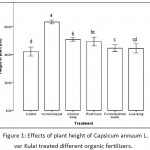 |
Figure 1: Effects of plant height of Capsicum annuum L. var Kulai treated different organic fertilizers.
|
Plant height in vermicompost treatment shows the highest plant height (63.38 cm) while control, with no organic fertilizer application, gives the shortest (42.12 cm ) chilli plant. This shows that application of organic fertilizers help to improve growth of chilli plant. Natesh et al. 7 state the organic fertilizer influenced significantly the growth parameter. This might be due to the improvement in soil physical condition for the plant growth along with increased availability of N, P and K at the early stage of crop growth.8 Nitrogen, phosphorus and potassium contained in organic fertilizer have great effects in plant growth and development. Plant need high concentration of this primary nutrient as any deficiency of these essential nutrients will prevent good plant growth.9 Thus, sufficient nitrogen, phosphorus and potassium supplied by organic fertilizer help in producing sturdy and taller chilli plant.
Number of Leaf Per Plant
The number of leaf produced by the chilli plant is presented in Figure 2 below.
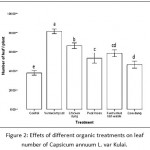 |
Figure 2: Effets of different organic treatments on leaf number of Capsicum annuum L. var Kulai.
|
Figure 2 shows that number of leaves produced is significantly affected by the application of different organic fertilizers. The least number of leaves was from control chilli plant. On the other hand, vermicompost treatment produced highest number of leaves. Abid et al10 stated the mineral nutrients had a good effect on growth of red chillies. As nitrogen is an essential part of chlorophyll, helps in protein synthesis. Increase in leaves number per plant may be due to sufficient amount of nitrogen provided an ideal environment and balanced nutrition to plants, which increased number of leaves. The results are to some extent in agreement with the findings of Deore et al 11 who obtained maximum number of leaves per plant with increasing nitrogen containing in liquid organic fertilizer.
Leaf Area
Leaf area of chilli plant from all six treatments was recorded and visualized as bar chart in Figure 3.
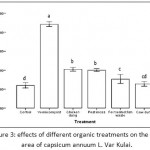 |
Figure 3: effects of different organic treatments on the leaf area of capsicum annuum L. Var Kulai.
|
The graph of the effect of different organic fertilizer on chilli leaf was statistically analysed and proven significant with p<0.05. From the Figure, the largest leaves area was recorded on treatments with vermicompost. While the least leaf area was recorded from control plant. Gopal et al.12 states the leaves area is large when nutrients content in organic fertilizer was increased. This is due to availability of dry matter in organic fertilizer that contain rich nutrients and higher light interception resulted in increased leaf area and high photosynthetic activity leads to an increase in the plant growth 13.
Number of Branch Per Plant
The number of branch emerged from the main stem of chilli plant was recorded and displayed as a bar chart in Figure 4.
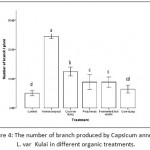 |
Figure 4: The number of branch produced by Capsicum annuum L. var Kulai in different organic treatments.
|
From the Figure 4, it shows that there was a significant difference for number of branch observed under difference application of organic fertilizer. The lowest number of branches was recorded from control plant with average of 5 branches per plant. Treatment 1, with vermicompost application gave the significant number of branch which is 24 branches per plant. This finding is also in conformity with the work of Baloch et al., 14 who reported the organic fertilizer contain most macro and micro nutrients along with NPK and mentioned that these fertilizers provide nutrients to the plant and significant effect on branches per plant.
Stomata Conductivity
Stomata conductivity of chilli plant was recorded and visualized as bar chart in Figure 5. From the figure, it can observe that there was a significant difference for stomata conductivity under application of difference organic fertilizers.
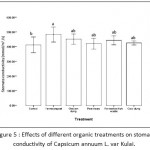 |
Figure 5: Effects of different organic treatments on stomata conductivity of Capsicum annuum L. var Kulai.
|
The highest value of stomata conductivity was obtained from treatment 1 with application of vermicompost and closely followed by chicken dung, peat moss fermented fish waste and cow dung. The control shows the lowest value stomata conductivity. Value of stomatal conductance was shown the passage rate of carbon dioxide (CO2) entering the leaf stomata and the value of water vapour exiting through the stomata of chilli leaf. Carbon dioxide is important for chilli plant as it was required in production of carbohydrates during photosynthesis process. As stated by Andrew and Davies,15 increases in the net rate of photosynthesis and stomata conductance of leaves are perceived to occur simultaneously.
Chlorophyll Content
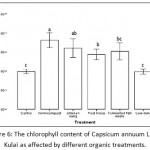 |
Figure 6: The chlorophyll content of Capsicum annuum L. var Kulai as affected by different organic treatments.
|
For plant chlorophyll content, Figure 6 shows that the application of vermicompost displayed the significant chlorophyll content, followed by chicken dung, peat moss and fermented fish waste. Control with no application of organic fertilizer and cow dung shows no significant difference as compared with other treatments. Chlorophyll component is made up from nitrogen and it is functioning in promoting vegetative growth and green colouration of plant foliage. Nitrogen involve in the formation of chlorophyll which lead to an effective photosynthesis rate of chilli plat. Yadav et al.16 stated that vermicompost is an excellent base for the establishment of beneficial free living and symbiotic microbes and it increases the total microbial population, nitrogen fixing bacteria and actinomycetes. The increased microbial activity improves the availability of soil phosphorus and nitrogen.
Number of flower Bud and fruit Per Plant
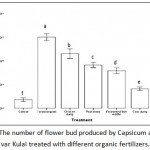 |
Figure 7: The number of flower bud produced by Capsicum annuum L. var Kulai treated with different organic fertilizers.
|
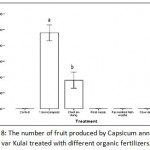 |
Figure 8: The number of fruit produced by Capsicum annuum L. var Kulai treated with different organic fertilizers.
|
Figure 7 shows the number of flower bud which was significantly higher in vermicompost treatment than chicken dung treatment. Abid et al.10 (2014), stated the highest number of fruits per plant might be due to vigor of plant and more number of leaves per plant. The results are in agreement with those of Roychaudhury et al.17 who reported that the number of fruit per plant increased with increasing nitrogen application.
From the Figure 8, the fruit was produced only in treatment supplemented by vermicompost and chicken dung. Application of vermicompost resulted in increasing of yield components due to increased photosynthetic activity and rate at which ultimately resulted in higher number of fruits per plant and seed yield per ha.18 Mogapi et al.19 reported the application of poultry or chicken manure which is the most widely used for growing crops increase the growth of crops, in line with the work of Adejoro20 who found poultry manure to increase growth and yield of Corchorus olitorius.
Weight of fruit
The weight of individual chilli fruit was recorded and demonstrated as a bar chart in Figure 9.
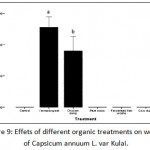 |
Figure 9: Effets of different organic treatments on weight of Capsicum annuum L. var Kulai.
|
From the figure, it shows there was a significant difference for weight of fruit measured under different application of organic fertilizers. The individual weight was significantly higher in vermicompost treatment followed by chicken dung treatment. For the rest of treatment there was no fruit produced. The positive response of the fruit yield to the vermicompost and chicken dung treatment could be due to the synthesis of more assimilate that played significant role in the production of more and bigger economic chilli fruits. Application of organic fertilizer will increase in values of fresh weights of the fruits per plant. Similar results were obtained by Abid et al.10 in chilli plants treated with organic fertilizers.
Diameter and Length of fruit
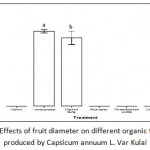 |
Figure 10: Effects of fruit diameter on different organic treatments produced by Capsicum annuum L. Var Kulai
|
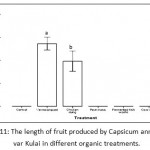 |
Figure 11: The length of fruit produced by Capsicum annuum L. var Kulai in different organic treatments.
|
Figure 11 representing the diameter measured of chilli fruit. Meanwhile, the length of fruit was recorded and represent in Figure 12. Treatment 1 has the highest significant difference of fruit diameter and mean fruit length (13.64 cm), which is slightly different with chicken dung ( 9.82 cm) as compared with the other treatments. The results are to some extent in agreement with Roychaudhury et al. 17who observed an improvement in fruit size with increasing nitrogen contents in organic fertilizer.
Number of Seed Per fruit
The number of seed produced by individual fruit was recorded and presented in Figure 12. The result obtained shows significant diiference amongst the treatments.
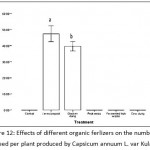 |
Figure 12: Effects of different organic ferlizers on the number of seed per plant produced by Capsicum annuum L. var Kulai.
|
The significant number of seed was obtained in chilli plant that were supplemented with vermicompost treatment, followed by chicken dung. The results are up to some extent in agreement with the findings of Sanjutha et al. 21 who obtained maximum number of seeds per fruit when the high content of nitrogen and potassium in organic fertilizers were applied.
Conclusion
From the overall results, treatment with vermicompost gives the highest plant height, higher number of leaves, high value of stomata conductance, high value of chlorophyll content, and highest number of flower bud. On the other hand, treatment supplemented with vermicompost and chicken dung gave positive effect in number of fruit produced, weight of fruit, length of fruit, diameter of fruit and seed number of fruit. Control treatment shows the lowest overall growth and yield performance in chilli plant. Thus, it can be concluded that application of organic fertilizer had significantly affect the growth, yield, and quality of chilli plant. Application of organic fertilizers helps to supply nutrient as required for growth and yield of chilli plant. The plants that were supplemented with vermicompost and chicken dung showed high rate in growth development, high yield and better quality of fruit. From the above results, we concluded that the tested vermicompost and chicken dung organics can improve the growth, yield and quality of chilli. Thus, the best of organics treatment for growth, yield and quality of chilli was vermicompost and chicken dung.
References
- Sparkyby F. Sparky Boy Enterprises. Planet Natural. 2006;1-6.
- Howard L. R., Smith R. T., Wagner A. B., Villalon B.,Burns E. E. Provitamin A and Ascorbic Acid Content of Fresh Pepper Cultivars (Capsicum annuum) and Processed Jalapeños. Journal of Food Science. 1994;59:362-365.
CrossRef - Vimala P., Melor R.,Shokri A. O and Balasubramaniam P. Effect of organic and inorganic fertilizers on growth, yield and nutrient content of bird chilli (Capsicum frutescence). Journal of Tropical Agriculture and Food Science. 2007;35:29-40.
- Nakhro N and Dkhar M. S. Impact of Organic and Inorganic Fertilizers on Microbial Populations and Biomass Carbon in Paddy Field Soil. Journal of Agronomy. 2010;9:102-110.
CrossRef - Ouda B. A and Mahadeen A.Y. Effect of fertilizers on growth, yield, yield components, quality and certain nutrient contents in broccoli. 2008;10:627–32.
- Zynudheen A. A., Anandan R and Nair R. K. G. Effect of dietary supplementation of fermented fish silage on egg production in Japanese quail (Coturnix coromandelica). African Journal of Agricultural Research. 2008;3(5):379-383.
- Natesh N., Vyakaranahal B. S., Shekhargouda M and Deshpande V. K. Effect of micronutrients and organics on growth, seed yield and quality of chilli. Karnataka Journal of Agricultural Sciences. 2010;18(2):334-337.
- Patil M. B., Mohammed R. G and Ghade P. M. Effect of organic and inorganic fertilizers on growth, yield and quality of tomato. Journal of Maharashtra Agricultural University. 2004;29:124-127.
- Gholizadeh A., Amin M. S. M.,Anuar A. R and Aimrun W. Evalution of SPAD chlorophyll meter in two different rice stages and its temporal variability. European Journal of Science Research. 2009;37(4):65-69.
- Abid K., Muhammad S. M. S., Abdu R., Sajid M., Kawsar A., Amjed A. And Faisal. Influence Of Nitrogen and Potassium Levels on Growt and Yield of Chillies (Capsicum annuum L.). International Journal of Farming and Allied Sciences. 2014;3(3):260-264.
- Deore G. B., Limaye A. S., Shinde B. M and Laware S. L. Effect of Novel Organic Liquid Fertilizer on Growth and Yield in Chilli ( L.). Asian Journal of Experimental Biological Sciences. 2010;8:15-19.
- Gopal M., Gupta A.,Sunil E and Thomas V. G. Amplification of plant beneficial microbial communities during conversion of coconut leaf substrate to vermicompost by Eudrilus sp. Current Microbiology. 2010;59:15–20.
CrossRef - Balraj T. H., Palani S and Arumugam G. Influence of Gunapaselam, a liquid fermented fish waste on the growth characteristics of Solanum melongena. Journal of Chemical & Pharmaceutical Research. 2014;6(12):1027-1035.
- Baloch Q. B., Chachar Q. I and Tareen M. N. Effect of Foliar Application of Macro and Micro Nutrients on Production of Green Chilies (Capsicum annuum L.). Journal of Agricultural Technology. 2008;4(2):177-184.
- Andrew J. J and William J. D. The coupled response of stomatal conductance to photosynthesis and transpiration. Journal of Experimental Botany. 1998;49(399):399-406. doi: 10.1093/jxb/49.
- Yadav A., Gupta R and Garg V. K. Organic manure production from cow dung and biogas plant slurry by vermicomposting under field conditions. International Journal of Recycling of Organic Waste in Agriculture. 2013;2(1):1-7.
CrossRef - Roychaudhury A., Chatterjee R and Mitra S. K. Effect of different doses of nitrogen, phosphorus, potassium, magnesium, calcium and iron on growth and developmentin chilli. Department of Horticulture Kalyani West Bengal India. 1995;13:96-99.
- Singh S. B., Singh T., Singh B. N and Singh S. S. Growth and yield of chilli (Capsicum frutescens L.) in relation to zinc levels and number of seedlings per hill. Haryana Journal of Horticultural Sciences. 1989;18:113-118.
- Mogapi E. M., Thembinkosi M., Christopher M.,Ndapo S and Machach S. Effect of chicken manure and commercial fertilizer on performance of jute mallow (Corchorus olitorius). Agriculture and Biology Journal of North America. 2013;4(6):617-622.
- Adejoro S. A., Okunlola A. I and Fakanlu G. Evaluation of Some Manure Types for the Growth and Yield of Watermelon in Southwestern Nigeria. Researcher. 2011;3:393-395.
- Sanjutha S., Subramanian C., Rani I and Maheswari J. Integrated Nutrient Management in Andrographis paniculata. Research Journal of Agriculture and Biological Sciences. 2008;4(2):141-145.

This work is licensed under a Creative Commons Attribution 4.0 International License.





